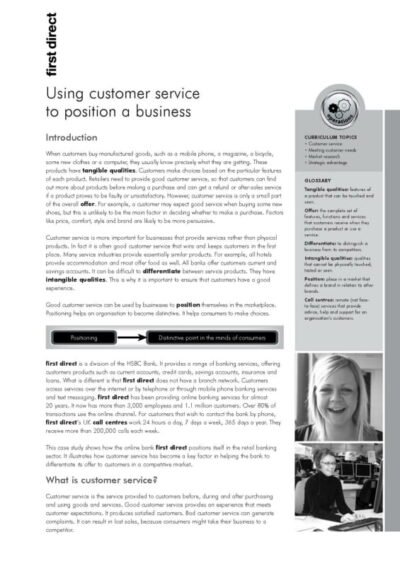
However, customer service is only a small part of the overall offer. For example, a customer may expect good service when buying some new shoes, but this is unlikely to be the main factor in deciding whether to make a purchase. Factors like price, comfort, style and brand are likely to be more persuasive.
Customer service is more important for businesses that provide services rather than physical products. In fact it is often good customer service that wins and keeps customers in the first place. Many service industries provide essentially similar products. For example, all hotels provide accommodation and most offer food as well. All banks offer customers current and savings accounts. It can be difficult to differentiate between service products. They have intangible qualities. This is why it is important to ensure that customers have a good experience.
Good customer service can be used by businesses to position themselves in the marketplace. Positioning helps an organisation to become distinctive. It helps consumers to make choices.

It provides a range of banking services, offering customers products such as current accounts, credit cards, savings accounts, insurance and loans. What is different is that first direct does not have a branch network. Customers access services over the internet or by telephone or through mobile phone banking services and text messaging. first direct has been providing online banking services for almost 20 years. It now has more than 3,000 employees and 1.1 million customers. Over 80% of transactions use the online channel. For customers that wish to contact the bank by phone, first direct ‘s UK call centres work 24 hours a day, 7 days a week, 365 days a year. They receive more than 200,000 calls each week.
This case study shows how the online bank first direct positions itself in the retail banking sector. It illustrates how customer service has become a key factor in helping the bank to differentiate its offer to customers in a competitive market.

Good customer service involves developing bonds with customers, hopefully leading to long term relationships. It creates advantages for both customers and the business alike. Customers benefit because the business is providing a service that meets their needs. The business benefits because satisfied customers are likely to be repeat customers. They will stay with the business. However, good customer service is not easily achieved. It takes time to establish. It requires investment to deliver consistent standards.
first direct‘s mission statement is ‘pioneering amazing service’. This means that customer service is used to set the direction for the business. In other words, customers come first. This is not an empty slogan. Market research shows that, in terms of customer satisfaction, first direct is the UK’s number one bank. It confirms that the bank has a reputation for quality customer service. This has also been demonstrated by comparative studies. The bank was the leading performer in the Top 50 Call Centres for Customer Service benchmarking programme and it came top in the Finance Sector in the Institute of Customer Services (ICS) Satisfaction Awards.

This involves respecting the business’ employees, as internal customers within the organisation, as well as external customers. Using this concept influences how colleagues and individuals at first direct act towards each other as well as how they deal with customers.
To achieve customer satisfaction, first direct sets and monitors service standards. For example, four out of five calls are answered within 20 seconds. On average a customer’s call is answered in 13 seconds. Customer service representatives are available around the clock. This means that customers always get to talk to a real person not a machine and they never have to push buttons before they get to talk to someone.

In this way, first direct gets to know its customers. It can even provide a personal touch, like occasionally sending flowers to a customer or their partner to mark a birthday.
To maintain these standards first direct identifies what customers expect from banks in terms of customer service provision. It then builds these customer expectations into the services it provides. For example, this involves:
- ensuring first direct colleagues are courteous and informed that they know about the bank’s products and services
- dealing with any complaints promptly and fairly
- following up sales
- offering informed guidance on any products that are available (subject to financial regulations).

Market research is a process that enables a business to find out more about its customers and markets. It provides direct feedback that can be used to build and refine services. First direct collects a range of data that identifies market trends through several research activities:
- First Impressions involves contacting new customers shortly after they join the bank. This primary market research helps the bank to assess their initial experiences of banking with first direct .
- Voice of the Customer is a programme of research that is conducted monthly amongst existing customers who have taken out a new product with first direct over the last couple of months.
- Focus groups, consisting of small groups of customers, are also held regularly to provide qualitative feedback on specific topics and issues.
- Quantitative research provides robust and representative feedback on a range of specific issues.

They also want the reassurance of being able to speak to a person rather than an automated machine. In a competitive market where customers are able to shop around for services, it is important for first direct to make sure that it gets its customer service right.
Market research also provides valuable information about how first direct ‘s services are perceived and experienced by customers. Research data shows that first direct has been ahead of its competitors in achieving overall customer satisfaction. It also shows that it is ahead of the competition in achieving customer satisfaction for an internet banking and a telephone banking service.

Training and development has an important role in preparing employees to provide good customer service. first direct aims to be a destination employer. This means it expects employees to remain with the bank for a large part of their careers. It benefits the bank because long-serving colleagues and employees can use their experience to provide a better service for customers.
Employees are selected for their skills and personality. It is important that new employees are able to reflect the first direct brand and deliver the brand’s service values. After appointment, new staff undergo six weeks of training (or nine weeks part time) with 65% of the time in a classroom environment and 35% integrating with dedicated coaches in the live working environment taking live calls. They also have ongoing coaching. The process of people development is designed to empower individuals to make decisions and take action in meeting the needs of customers. From the very start, new employees need to show a commitment to delivering high standards of customer service. In the first few days of training they engage with the culture of the business. They meet with their new team leader, listen to some live calls, experience the business values and understand how first direct treats its customers fairly. This helps them to understand the core values of customer service delivery.

Another way of meeting customer needs is through the bank’s website. The website must be easy to use. This helps customers to complete their transactions. The first direct website is constantly monitored to look for areas of improvement. It has one of the best security systems in the banking industry to prevent fraud. first direct was also the first bank to develop a platform for iPhone banking. It is now possible for customers to receive real-time balances direct to their mobile phone.

Market research clearly shows that customers enjoy and are satisfied with the bank’s services. This means that they are more likely to remain with the bank. Customer retention is important to any business. Marketing and promoting a bank to new customers can be expensive. It is much more efficient to keep existing customers than focus resources on searching for new ones.
Satisfied customers are also good adverts for the bank. Market research shows that customers are happy to recommend first direct to other people. A person who really likes a service and recommends it to others is called an advocate. One in three of new customers come to the bank as a direct result of recommendations from existing customers.
Providing good customer service also means that customers have fewer complaints. Dealing with complaints can be costly. So, again, by providing good customer service, the bank can reduce the costs of resolving customer problems.

As an online bank with no branches, first direct could come across as a faceless organisation. However, by listening to customers, by paying attention to all aspects of service and customer communication, the bank has built up a loyal customer base. It has achieved a unique position within the banking industry.
 Flexible working patterns (MP3)
Flexible working patterns (MP3)  Using customer service to position a business (PDF)
Using customer service to position a business (PDF) 